Known as the Salamander that never grows up, Axolotls are just so gosh darn cute and wonderful to own as a pet.
If you’re looking for a truly one-of-a-kind pet, the smiling axolotl with its unique and clumsy characteristic is exactly what you’re looking for.
This guide will teach you the requirements for an easy-to-maintain tank and how to provide proper axolotl care so it thrives.
Table of Contents
Axolotl Care Overview
Axolotl Quick Care Information
Key Characteristics
- Size: 6-18 inches
- Life span: 10-15 years
- Living zone: Bottom
- Diet: Carnivorous
- Tank mates: None
Water Parameters
- Temperature: 60-68°F (15-20°C)
- pH: 7-7.4
- Chlorine and Chloramines: 0 ppm
- Ammonia: 0 ppm
- Nitrite: 0 ppm
- Nitrate: 5-20 ppm
Care Schedule
- Feed adults every 2-3 days
- Feed Juveniles daily
- 20% water change weekly
Scientific Classification
- Common Names: Axolotl, Mexican walking fish, Mexican Salamander
- Scientific Name: Ambystoma mexicanum
- Species: A. mexicanum
- Family: Ambystomatidae
- Genus:Ambystoma
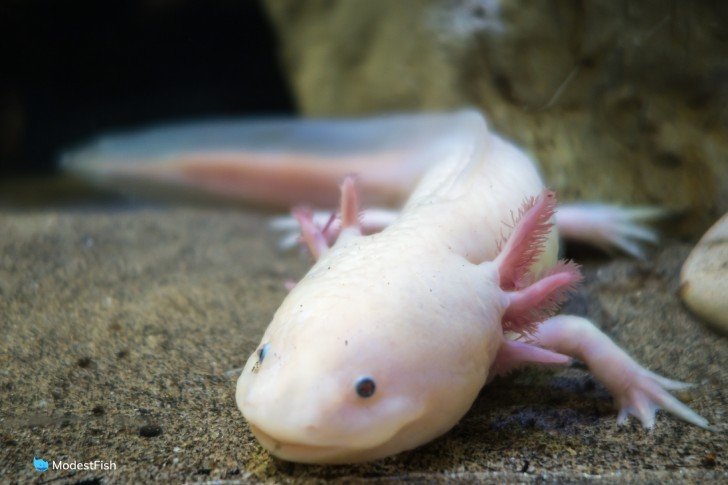
Tank Setup Overview
Tank Supplies
29 gallon tank or greater
Sponge filter, HOB filter, or Canister filter
Air pump & Air stones
Thermometer
Fine sand substrate
Live Plants
Dimmable LED lights
Decorations
Aquarium fan or water chiller
API Master Test Kit
Water Conditioner
Gravel vacuum
5 gallon bucket
Silicone feeding tongs
Diet
Earthworms
Axolotl pellets
Blackworms
Bloodworms
Brine shrimp (juveniles)
Baby Daphnia (juveniles)
Microworms (juveniles)
Axolotl Species Profile & Habitat
The axolotl (Ambystoma mexicanum), also known as the Mexican salamander and Mexican walking fish, originates from several freshwater lakes (Lake Xochimilco & Lake Chalco) in Mexico.
Despite being categorized as a fish, the axolotls are amphibian from the family Ambystomatidae. Unlike other amphibians, the axolotl reach adulthood without going through metamorphosis, never taking to land, remaining aquatic and gilled.
It was the Aztecs back in the 13th century who originally named the axolotl after their god of fire and lighting “Xolotl” and it was then the axolotl became an icon of mesoamerican culture.
The axolotl was first introduced to Europe in 1863 to study their ability to regenerate their limbs, Axolotls quickly became a darling of the aquarium hobby due to their unique biology and their cute faces and infectious smile.

A fully grown axolotl will be anywhere from 8-16 inches in length (15-45cm) and will be quite the looker with their wide head, lidless eyes, and four long thin legs with elongated fingers.
Axolotls also have filament-lined gill stalks (which are called rami) that stick out from the back of their necks.
But, it’s their regeneration abilities which intrigues and bewilders. Axolotls have the ability to regrow almost any body part – arm, feet, legs, heart, or even the brain. In fact, Axolotls have the largest animal genome ever sequenced: 32 billion (10x larger than humans).
Sadly, the world’s only remaining wild axolotl live in Lake Xochimilco.
Because of their scarcity, axolotls are listed on the International Union for Conservation of Nature’s annual Red List of threatened species. The population took a massive hit when Lake Calcho (axolotl’s native Mexican habitat) was drained to avoid flooding.
As a result, huge numbers of axolotls were killed while the remainder began populating the canals of Xochimilco. However, their species is thriving in the aquarium hobby. And when provided with proper care and maintenance, an axolotl can live up to 17 years.
Aquarium & Equipment Requirements
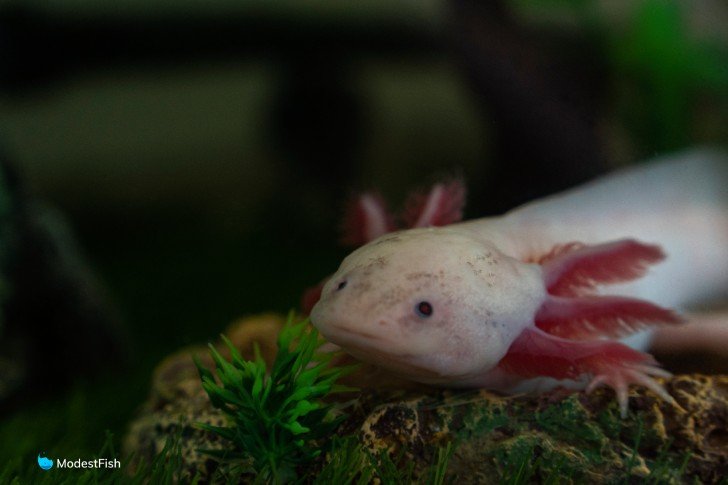
- 29 gallon tank or greater
- Sponge filter, HOB filter, or Canister filter
- Air pump & Air stones
- Thermometer
- Fine sand substrate
- Live plants
- Dimmable LED lights
- Decorations
- Aquarium fan or water chiller
- API Master Test Kit
- Water Conditioner
- Gravel vacuum
- 5 gallon bucket
- Silicone feeding tongs
- Turkey Baster
Tank Size For Axolotl
29 gallons is the smallest tank I can recommend you buy for your axolotl (110 liters). However the larger tank you can get the better it’ll be for your axolotl (even for a juvenile). The larger body water means any issues with water quality will be diluted, causing less stress on your axolotl.
When choosing your tank, prioritize length and width over height, as your axolotl will spend much of its time chilling on the bottom.
Filtration
Axolotl’s are famous for the amount of waste they produce, so having a filter is a non-negotiable. It’ll help you establish the nitrogen cycle (more on that later), and help maintain stable water parameters.
Because of how clumsy axolotl are, they’re not the best swimmers and prefer low amounts of water flow.
Using a sponge filter or hang-on-the-back filter are excellent options I would recommend. However, if you live in a warmer climate, you may require an aquarium chiller which is best paired with a canister filter.
If you are concerned about the amount of water flow in the tank, consider using a spray bar, aquarium plants, or decorations to help buffer the outlet tube.
When picking your filter, ensure the GPH is 4x the size of your tank. For example, a 29 gallon tank would require a filter with a GPH of at least 116.
Substrate
I recommend CaribSea Super Natural moonlight sand. It’s the safest substrate for axolotls currently available. A lot of people opt for bare-bottom tanks, and while these are fine, I would recommend you go with a sand substrate with 1mm diameter grain size.
Having a sand substrate gives your axolotl something to grip on when moving about, allows for you to have live aquarium plants, and improves the overall aesthetics.
Never use gravel or substrates with large grains as axolotls can swallow them, causing impaction. Which can harm or kill your axolotl.
Lighting
Axolotls have poor vision and no eyelids, making them extra sensitive to bright lights. You can therefore get away with simple ambient room lighting.
However, I always believe having live plants in your tank improves the water quality for your axolotl. Therefore, I recommend you get some LED lights with programmable features.
A cheap light like the Hygger 24/7 LED kit can be dimmed, as to not stress for axolotl whilst providing enough light to keep some low-light aquarium plants (recommendations below). Programmable lights means you can set a consistent schedule of 8 hours a day.
Plants
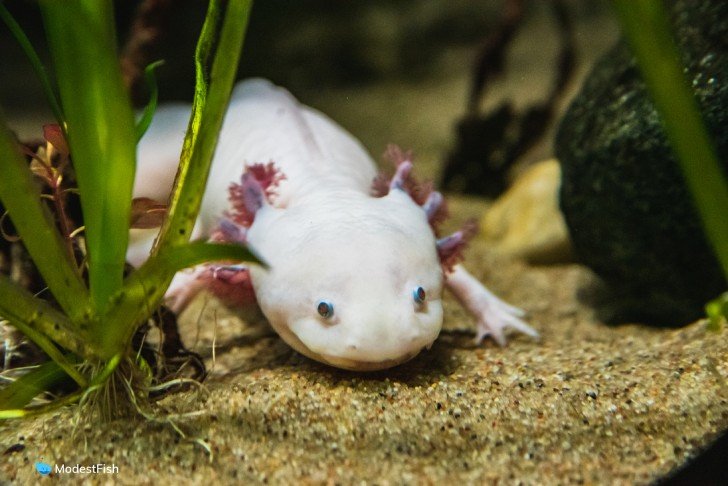
Live aquarium plants will give more life to your axolotl tank, provide them with natural places to hide and explore, as well as helping remove small amounts of nitrates from your water column, keeping it a healthier environment.
But, not all plants are suitable for axolotls as they require minimal lighting and need to be hardy enough to live in colder water conditions. You’re also unable to use any liquid fertilizers because axolotls have semi-permeable skin, meaning they’ll absorb these right into their skin. Not good.
Some suitable plants for axolotl you can look into are:
- Amazon sword
- Cryptocoryne
- Water wisteria
- Marimo moss balls (must be larger than the head)
- Bacopa
- Anubias
- Java moss
- hygrophila siamensis
- Java fern
- Ludwiga
Before you go adding plants, be aware they might carry unwanted hitchhikers. Therefore you can perform a hydrogen peroxide (H2O2) dip.
Equipment:
- 3% Hydrogen peroxide
- Bucket large enough for one gallon of water
- Gloves
- Aquarium plant
- Dechlorinator
Process:
- Prepare a mix of water with added dechlorinator (for rinsing later)
- Mix 3% H2O2 in 1 gallon of water
- Dip your plants in for 5 minutes
- Thoroughly rinse the plants in a water solution prepared with a dechlorinator and allow to soak for a few minutes.
I also recommend a two week quarantine period in a separate tank before adding any to your tank. This will help reduce the change of pest snails making their way into your tank.
Decorations and Hardscape
Decorating an axolotl tank with a hardscape is very simple. Ensure there are no rough edges and they’re aquarium safe and you’re good to go.
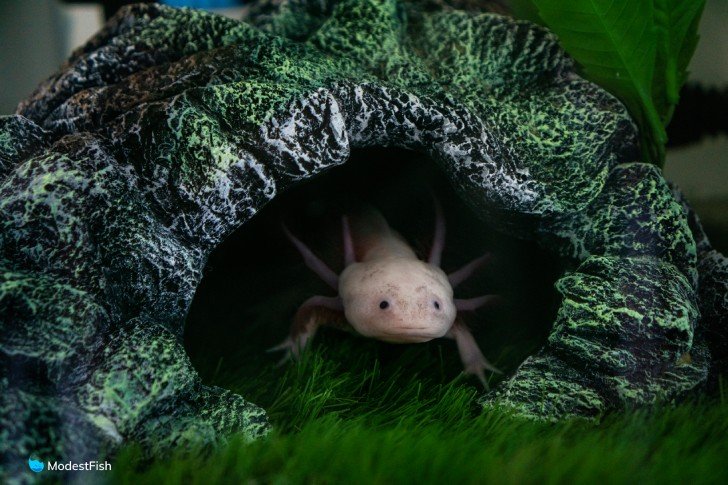
PVC piping, terracotta pots, and even glass jars can all work and are excellent places for your axolotl to explore and hide in. If you’re going to use fake plants, I recommend silk plants over plastic and they can often be rough and damage your axolotl.
Just make sure you leave enough floor space for your axolotl to easily get around.
Water Parameters
- Temperature: 60-68°F (15-20°C)
- pH: 7-7.4
- Chlorine and Chloramines: 0 ppm
- Ammonia: 0 ppm
- Nitrite: 0 ppm
- Nitrate: 5-20 ppm
- General Hardness: 7-14 GH
- Carbonated Hardness: 3-8 KH
Cycling the Aquarium
Before you can house your axolotl, your tank’s water must go through the nitrogen cycle in order to provide safe and stable water parameters.
During this process, you establish beneficial bacteria in your filter’s media that’ll then turn ammonia (poisonous), into nitrites (poisonous), into Nitrate (not so poisonous).
You can learn exactly how to do this with our step-by-step guide on cycling your tank.
Keeping Axolotls Water Cool
If you live in a cooler climate, you may not need to take any action in order to keep your tank’s water at a stable 60-70°F (15-23°C).
Otherwise, here’s how to keep the tank water cool:
- Aquarium chillers: expensive, and must be paired with a canister filter, but is the most reliable and consistent method for keeping the tank water at the correct temperature.
- Aquarium fan: aimed across the water surface will help keep the water cool.
- Evaporation and aeration: Use air stones to make bubbles, which in turn will cause evaporation on the surface and cool the water.
- Mesh lid: using a mesh lid will allow heat to escape the tank
- Frozen dechlorinated water bottles or dechlorinated ice cubes: In case of an emergency, this can help to cool down the tank water.
Maintenance Schedule & Equipment
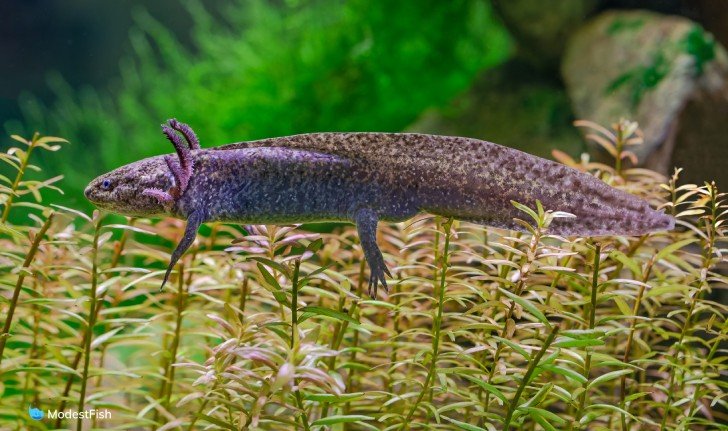
To perform necessary weekly 20% water changes on your tank, you’ll need a siphon or gravel vacuum. We’ve tested gravel vacs and found Aqueons large gravel cleaner is best for tanks 40 gallons or over and Fluval’s Easy Vac is best for tanks around 30 gallons.
You can read more about our aquarium gravel vac test here.
What you’ll also need is a 5 gallon bucket to change out 20% of the water. And a water conditioner to make tap water safe to add to your tank.
If you’re keeping live plants, some aquascaping kit with tweezers and scissors for trimming plants when needed will be useful.
Water testing kits are a must. The main parameters you want to test for weekly are pH, ammonia, nitrites, and nitrates.
We tested different brands against laboratory tests and found the API Master Test kit was the most accurate and reliable. It also tests for everything you need to check for.
Feeding Axolotl
Adult axolotls (over 3 inches), can be fed earthworms and axolotl pellets (look for products with at least 45% protein). You can then rotate in bloodworms and live black worms to keep their diet interesting and offer some treats.
Feed an adult 1-2 large worms every 2-3 days. If you’re unsure if you’re feeding too much or not enough, aim for your axolotl to have an abdomen the same size as its head.
Juvenile axolotls (under 3 inches), can be fed on a diet of brine shrimp, baby daphnia, and microworms. Once they start growing their legs, blackworms will be the best choice of food. New hatchlings require multiple feedings per day and juveniles will eat 2-3 times per day until they’re over 3 inches.
Tank Mates
Don’t let axolotl’s friendly disposition, large smiley-face, and all-round cuteness fool you. They’re voracious carneous that’ll eat anything they can fit in their mouths.
They’re not sociable, do not care for tank mates, and there is no benefit for them to house multiple together. You might see others online successfully housing multiple, but I wouldn’t recommend it, especially if you’re new to owning them.
It’s so common for them to nip and mistake each other for food, they produce so much waste, you’ll be having to do constant water changes as nitrate levels will quickly rise. Keeping more than one in a tank creates danger with little to no benefit.
Breeding Axolotls
Unless you’re planning to be a reputable breeder who understands genetics and lineage of your axolotls, do not breed or plan to breed.
The captive axolotl population is very inbred, causing a number of genetic issues. If you do accidently breed axolotls, it’s very important you cull all the eggs humanly by freezing them.
Common Health Problems
If you provide optimal care for your axolotl, it can live up to 15 years. A sign your axolotl is healthy would be:
- Fluffy gills
- Round belly (same size as head)
- Gills back
- No skin damage
- Active (for an axolotl)
However, there are a number of illnesses and injuries that axolotls can sustain. It’s vital that you learn how to treat these effectively so that you can bring your pet back to health quickly.
The common health problems in axolotls are:
Stress
Stress is one of the biggest causes of illness in axolotls. Common signs of a stressed axolotl would be for them to lose their appetite, refusing to eat normally. Curling/hooking of the tail and forward-turning gills
If signs of stress are showing, check the following:
- Water flow
- Temperature
- Test water parameters
Injury
Axolotls have the ability to regenerate damaged tissue, so a lost leg shouldn’t be any alarm to you. However, the risk you want to manage here is infection.
Exposed wounds can quickly become infected, so during this period you need to monitor water parameters and ensure they are stable.
Impaction
Impaction is a condition found in axolotls when the digestive system becomes dysfunctional.
Symptoms of impaction include:
- Refusal to eat for multiple days
- Bloating
- Low waste production
Often, this is caused when they ingest gravel or small stones, which is why it’s crucial that you house your axolotl with an appropriate sand-based substrate.
In the case of impaction, fridging can encourage fast recovery and help them to eject anything nasty in their digestive system. Constipation as a result of overfeeding can also cause impaction, which is why adults should only be fed every 2-3 days at most.
Floating Axolotls
Axolotls are able to float around tanks at will, this should only become a concern if:
- Your axolotl is unable to return to the bottom of the tank
- They float up against their will
- They float very often
- They appear distressed when floating
Again, fridging can help get rid of this problem. You should also check your water parameters and adjust them if necessary.
Bacterial/Fungal Infections
Heat-stressed axolotls can develop dangerous bacterial and fungal infections, which is why you should routinely check your water temperature.
Common illnesses include ‘red leg’ bacteria, characterized by red patches on the limbs; Columnaris, characterized by sluggishness and white gray patches; and Saprolegnia, characterized by white patches on skin and gills.
These can all be treated using a salt bath or fridging.
Axolotl Fridging
Axolotls are native to cold water. For that reason, you can use lower temperatures to slow disease and infection.
It’s also beneficial for impaction:
In cool temperatures, undigested food is ejected to prevent rotting.
To fridge an axolotl:
- Make sure your fridge is between 5-8 degrees Celsius
- Prepare a container of dechlorinated water (not chilled) long enough for your axolotl to stretch to its full length. The container should have a lid with air holes and space at the top for the axolotl to jump up for air.
- Transfer the diseased axolotl to the container and cover with a towel to prevent light disturbance.
- Once in the fridge, change water daily, replacing old water with dechlorinated, refrigerated water.
- Keep the axolotl refrigerated until it recovers.
- Gradually re-introduce your axolotl to tank water before returning it.
Axolotl Salt Bath
You can use salt baths to treat axolotls suffering from skin infections, which is most effective when used in conjunction with fridging.
Axolotls with fungal infections will benefit from salt bathing. The salt works to kill off any infection, nursing axolotls back to health within a few days.
Salt baths should be given twice daily during infection, for 10 minutes at a time.
- Mix 1-2 liters of dechlorinated water with sea, rock, or aquarium salt. Avoid table salt.
- Refrigerate to the same temperature the water you’re using for fridging.
- Remove the container from the refrigerator once cooled and shake.
- Fill your salt bathtub and add your axolotl.
- Leave for 10-15 minutes maximum.
- Remove from the tub and return to the fridging container.
- Repeat every 12 hours until the infection clears, and for 2-3 days after to kill any remaining fungus.
Are Axolotls Right For You?
If you’re willing to put the time into providing the right tank, water parameters, and diet for an axolotl, then owning one will bring you a ton of entertainment.
Their adorable, wide-grinned face and clumsy nature makes them one-of-a-kind. They don’t take any special care and attention, but they are susceptible to stress, so being disciplined with your tank maintenance is a must.
Use this axolotl care guide I have provided you to ensure your pet lives a healthy and happy life.
FAQs:
How is axolotl pronounced?
Ak-suh-lot-uhl.
How big do axolotl grow?
Axolotls can grow between 6-18 inches
How long so axolotl live for?
Up to 15 years, approximately 10 years on average
How to sex axolotl
Males are longer, with a swollen cloacal region. Females have larger, rounder bodies for egg storage.

Are Axolotls happy to be alone in tank?
Hello, Louisa, thank you for your comment. Yes, Axolotls are happy to live alone.
mine is happy and cute.they are so adorable!
Can axolotl survive in tap water as long as there is an appropriate filter in the tank (meaning WITHOUT the use of a conditioner or purified water etc, only a filter)?
Thank you for your comment, Angelika. I’m sorry but it’s hard for me to answer this question. It really depends on the quality of your tap water, so you would need to test this and see what it contains.
Axolotls are extremely sensitive to bad water or changes in it. This means that if there is enough of a contaminate in the water example chlorine. The Axolotl would not be good I’m not entirely sure what would happen but it would be bad. So yes you have to use a conditioner.
Thank you so very much I and Maybe getting one I learn so much thank you so very much!
Thanks for sharing!
I just got my Axolotl today, introduced it to the water, made sure that the water is in good condition, (which it is), and then put him in. Right now, he has a curled tip of his tail. Is this normal for Axolotls to have the curled tip and be a little stressed when you first put them in their new tank? Should I be concerned?
A curled tail can be a sign of stress. But, if he’s in a brand new environment, give him some time to settle in. It’s not uncommon for animals to experience some levels of stress in these situations.
this helped me to help my axolotle cus im a first timer